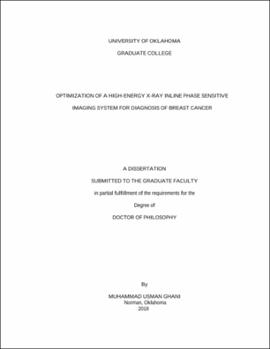| dc.contributor.advisor | Liu, Hong | |
| dc.contributor.author | Ghani, Muhammad | |
| dc.date.accessioned | 2018-04-16T20:16:30Z | |
| dc.date.available | 2018-04-16T20:16:30Z | |
| dc.date.issued | 2018-05-11 | |
| dc.identifier.uri | https://hdl.handle.net/11244/299328 | |
| dc.description.abstract | Breast cancer screening modalities have received constant research attention that are mainly focused on their abilities to detect cancer at an early stage while reducing the risks of harmful radiation dose delivered to the patient. As a result, numerous advancements have been made over the last two decades which include the introduction of digital mammography (DM) and digital breast tomosynthesis (DBT). Numerous clinical trials have demonstrated the decrease in mortality rates by employing these modalities. Significant research attention remains focused on investigating methods for further improving the detection capabilities and reducing the radiation dose. The conventional x-ray imaging technique relies on the attenuation characteristics of a tissue to produce imaging contrast. However, the similar attenuation characteristics of normal and malignant breast tissue present a challenge in differentiating between them using conventional x-ray imaging. The current technique for providing higher image quality involves the introduction of anti-scatter grids and operating the x-ray tubes at much lower x-ray energies as compared to the other radiography fields, both of which results in an increased radiation dose. The current method for providing higher image quality involves utilizing anti-scatter grids and operating at much lower x-ray energies than other radiography fields, both of which result in an increased radiation dose. Phase sensitive imaging is an emerging technique, which relies not only on attenuation coefficients but also the effects produced by x-ray phase shift coefficients. Within the diagnostic energy range, it has been estimated that the phase shift coefficients of a breast tissue are at least 2-3 orders of magnitude larger than their attenuation coefficients. Thus, this technique holds the potential to increase the x-ray energy and remove the grid without compromising the image quality, which could potentially reduce the patient dose. The inline phase sensitive approach involves the simplest implementation—provided that the imaging system is spatially coherent — as it does not involve the introduction of any optical element between the object and detector. Preclinical studies with the inline phase sensitive imaging technique at the same energy as conventional imaging have indicated the ability to reduce the radiation dose without negatively impacting the diagnostic capabilities. However, there are some existing challenges that have prevented this technique in its clinical implementation. Responding to the challenges, an inline phase sensitive imaging prototype has been developed in the advanced biomedical imaging laboratory. The goal of the research presented in this dissertation comprises a thorough investigation in optimizing a high energy phase sensitive imaging prototype efficiently in terms of its geometric and operating parameters. Once optimized, the imaging performance of this phase sensitive x-ray imaging prototype is going to be compared with the commercial digital mammography and digital breast tomosynthesis (DBT) imaging systems using modular breast phantoms at similar and reduced mean glandular dose (Dg) dose levels.
This dissertation includes numerous original contributions, perhaps the most significant of which were the demonstration of the ability of inline phase sensitive imaging prototype to deliver higher image quality required for tumor detection and diagnosis at higher x-ray energies in comparison with low energy commercial imaging systems at similar or less radiation dose levels. These results clearly demonstrate the ability of the high energy inline phase sensitive imaging system to maintain the image quality improvement that is necessary for diagnosis at high x-ray energies without an increase in the radiation dose. | en_US |
| dc.language | en_US | en_US |
| dc.subject | x-ray phase contrast imaging | en_US |
| dc.subject | phase retrieval | en_US |
| dc.subject | breast cancer imaging | en_US |
| dc.subject | phase sensitive imaging | en_US |
| dc.title | Optimization of a High-Energy X-Ray Inline Phase Sensitive Imaging System for Diagnosis of Breast Cancer | en_US |
| dc.contributor.committeeMember | Ahmad, Ramadan | |
| dc.contributor.committeeMember | Zheng, Bin | |
| dc.contributor.committeeMember | Shi, Zhisheng | |
| dc.contributor.committeeMember | Havlicek, Joseph | |
| dc.date.manuscript | 2018-04-03 | |
| dc.thesis.degree | Ph.D. | en_US |
| ou.group | College of Engineering::School of Electrical and Computer Engineering | en_US |
| shareok.orcid | 0000-0002-3308-0989 | en_US |
